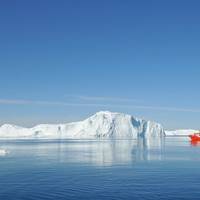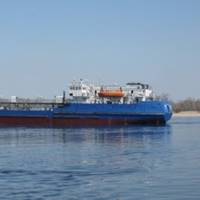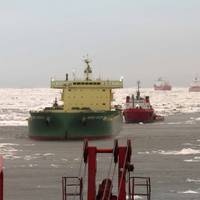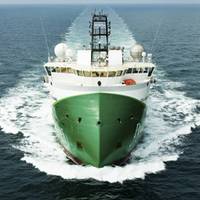The Growth in Arctic’s Role in Geostrategic Competition
The Arctic’s role in geostrategic competition is growing, in large part because reductions in permanent sea ice have exposed coastal borders and facilitated increased human and economic activity, said the U.S. Coast Guard’s Arctic Strategic Outlook.The warming of the Arctic has led to longer and larger windows of reduced ice conditions. From 2006 to 2018, satellite imagery observed the 12 lowest Arctic ice extents on record.1 This has led to greater access through Arctic shipping routes.While the near-term future of these routes is uncertain, a polar route has the potential to reduce transit times of traditional shipping routes by up to two weeks.Russia’s establishment of a Northern Sea Route Administration…
Maersk Tests Russian Arctic Route
The Danish-flagged cargo ship Venta Maersk, owned by the world's biggest shipping group A.P. Moller-Maersk, has successfully passed through the Russian Arctic, in a trial voyage showing that melting sea ice could potentially open a new trade route from Europe to east Asia.Palle Laursen, the chief technical officer of A.P. Moller-Maersk saying that the cargo vessel has made the journey as a one-off trial. “The trial allowed us to gain exceptional operational experience, test vessel systems, crew capabilities and the functionality of the shore based support setup,” he said.Laursen said the ship, which had a cargo of frozen fish, arrived in St. Petersburg on Friday, after leaving Russia's Pacific port city of Vladivostok on Aug. 22.
Arctic Shipping Routes: P&I Insurance FAQs
The UK P&I Club has compiled an FAQ which focuses on the implications for P&I insurance of choosing to use the Northern Sea Route. The Northern Sea Route (NSR), or North East Passage, runs along the Russian coast from the Atlantic to the Pacific through the Kara, Laptev, East Siberian, and Chukchi Seas, having the potential to significantly shorten voyage times between European and Far Eastern ports. The exact routing is variable and depends on the time of the year, ice conditions, and the size and draft of the ship in question. The route has long been used by Russian shipping for domestic purposes, but, with climate change reducing levels of Arctic sea ice, has been used for commercial voyages by international shipping since 2009 and numbers of such transits have steadily increased.
ABS Advises on Northern Sea Route Navigation

ABS, a provider of global maritime classification services, today released its Navigating the Northern Sea Route Advisory to support shipowners and operators intending to transit the increasingly popular commercial shipping routes through the Arctic seas. The comprehensive advisory, which was developed with assistance from Russia's Central Marine Research and Design Institute, provides owners with the information they need to apply for permits and to identify the possible technical…
U.K., Russia Enter Navigational Technology Collaboration

The General Lighthouse Authorities of the U.K. and Ireland (GLAs) are cooperating with The Internavigation Research and Technical Center in the Russian Federation to achieve compatibility in advanced navigation technologies. The common goal is to improve shipping safety across hazardous new high Arctic routes, which are playing an increasingly important role in international trade. The U.K./Russia cooperation refers specifically to the development of interoperable resilient position…
Drifting Arctic Tankship Gets Icebreakers Escort

The “Nordvik”, which had been drifting in remote Arctic waters following a collision with an ice floe, is now being accompanied by icebreakers to its home port, reports the 'Barents Observer'. Citing the Russian Sea and River Transport Agency, Barents Obsever says that a total of 1800 litres of diesel oil was transferred from the “Nordvik” into the tanker “Boris Vilkitsky”. The two vessels are now accompanied by two nuclear-powered icebreakers, the “Taymyr” and the “Vaigach”, out of the Matisen strait, bound for the tankship's home port of Khatanga.
Russia Shuts Greenpeace Out of Arctic Sea Route

The Russian government has reportedly denied permission for the Greenpeace icebreaker Arctic Sunrise to enter the increasingly busy Northern Sea Route (NSR), despite the ship having fulfilled all the requirements for such an entry. Greenpeace International beleives the decision is an attempt to prevent it from exposing the activities of Russian state-owned oil company Rosneft. Multiple vessels contracted by Rosneft and U.S. partner ExxonMobil are conducting seismic testing and geological work in the Kara Sea in preparation for offshore Arctic drilling.
Northern Sea Route 2013 Queue Longest Yet

The Northern Sea Route administration has so far given 54 vessels permission to sail the route in 2013. This year’s sailing season on the Northern Sea Route between Europe and Russia will probably be the busiest one ever. The first vessels to take the Arctic shortcut this summer will leave Murmansk at the end of June. The Northern Sea Route Administration has so far received 89 applications to use the Northern Sea Route (NSR). 54 vessels have so far been given permission to sail along the route, reports the Barents Observer, citing the administration's (Russian language) web-site.
Russian Presidential Decree Establishes NSR Administration

From an office in downtown Moscow, 15 people will regulate traffic along Russia’s Northern Sea Route. A decree signed this week by Prime Minister Dmitry Medvedev marks the formal establishment of the new Northern Sea Route administration. The office, situated far from the route, is to be part of the federal Agency of Sea and River Transport, reports the Barents Observer. By mid-May, the new structure is to be fully operational. The establishment of the office comes as shipping along the Russian Arctic route is increasing quickly.
Polarcus Alima travels the Northern Sea Route

One of the X-BOW vessels designed by ULSTEIN, the seismic vessel ‘Polarcus Alima’, recently transited to Asia-Pacific via the Northern Sea Route (NSR). This is the first known passage of a 3D seismic vessel along the Northern Sea Route. Her passage commenced on September 15 from Hammerfest in Norway after completion of seismic operations in the Barents Sea. After only nine days and 3,000 nautical miles the vessel reached Cape Dezhnev in the Bering Straits. She is presently continuing her onward passage to New Zealand to commence operations there.





